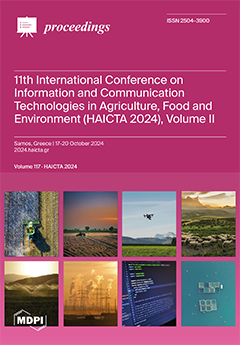Need Help?
Proceedings, 2025, HAICTA 2024
Samos, Greece | 17–20 October 2024
Volume Editors:
Thomas Bournaris, Aristotle University of Thessaloniki, Greece
Athanasios Ragkos, Agricultural Economics Research Institute, Hellenic Agricultural Organization—DIMITRA, Greece
- Issues are regarded as officially published after their release is announced to the table of contents alert mailing list.
- You may sign up for e-mail alerts to receive table of contents of newly released issues.
- PDF is the official format for papers published in both, html and pdf forms. To view the papers in pdf format, click on the "PDF Full-text" link, and use the free Adobe Reader to open them.
Cover Story (view full-size image):
The second volume contains selected short papers from the 11th International Conference on Information and Communication Technologies in Agriculture, Food and Environment (HAICTA 2024), held in
[...] Read more.
The second volume contains selected short papers from the 11th International Conference on Information and Communication Technologies in Agriculture, Food and Environment (HAICTA 2024), held in Samos, Greece, on 17–20 October 2024. The conference is organized by the Hellenic Association on Information and Communication Technologies in Agriculture, Food and Environment (HAICTA), the Greek branch of the European Federation for Information Technology in Agriculture (EFITA). The conference aims to bring together professionals, experts, and researchers working on Agriculture, Food, and Environment, emphasizing the applicability of ICT solutions and innovations to real industry cases addressing modern challenges.
Previous Issue
Next Issue
Issue View Metrics
Multiple requests from the same IP address are counted as one view.



